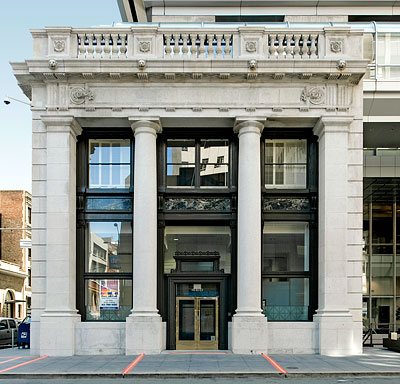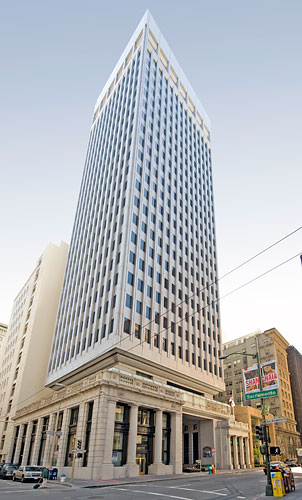San Francisco Landmarks
Italian American Bank
460 Montgomery Street Between California and Sacramento
Built 1907
Architect John Galen Howard designed this 1907 bank building to replace a bank that was destroyed by the 1906 Earthquake and Fire. The construction is steel-frame and concrete with granite columns in the Tuscan style. Howard was best known as the supervising architect of the Master Plan for the Berkeley Campus of the University of California. He personally designed many of the most distinguished buildings on campus, including Sather Gate and Sather Tower (the campanile), the Hearst Mining Building, the Greek Theater, Doe Library, California Hall, Boalt Hall, Hilgard Hall, Stephens Hall, the Architecture Building, and the Women's Faculty Club.
In an act of extreme and multiple façadism, the architectural firm of Roger Owen Boyer and Associates gutted this building and the neighboring Borel Building (San Francisco Landmark 109) to create a ground floor for a highrise office tower.
Historian and architectural critic , Randolph Delehanty, notes that 456 Montgomery Plaza is notable for its column free interiors: the walls of the new structure are load-bearing. While the preservation of the old banks was a good idea, and the modern silver tower is competent, the entrance between the historic banks is clumsy and unsatisfactory.... from Ultimate Guide: San Francisco, Chronicle Books, 1989.
Susan Dinkelspiel Cerny in her Architectural Guidebook to San Francisco and the Bay Area (Gibbs Smith, 2007) is less forgiving: Two small, very fine, granite banking-temple façades were retained as the entrance for a mid-1980's office building. This is one of the saddest examples of façadism in the city.
I concur with Ms. Cerny. Whenever I pass this corner I want to avert my eyes as if I had stumbled upon a scene of delicate living things being heedlessly crushed by something monstrous.

Façadism
Wikipedia defines Façadism (or Façadomy) as the practice of demolishing a building but leaving its façade intact for the purposes of building new structures in it or around it.
The International Charter for the Conservation and Restoration of Monuments and Sites (The Venice Charter of 1964) provided the doctrinal foundation for the modern preservation movement.
Although the United States did not participate in the preparation of the charter, the charter provided the basis for the Secretary of Interior's Standards for Historic Preservation. US/ICOMOS was founded in the 1960s to foster heritage conservation and historic preservation.
Article 1 of the Venice Charter
The concept of a historic monument embraces not only the single architectural work but also the urban or rural setting in which is found the evidence of a particular civilization, a significant development or a historic event. This applies not only to great works of art but also to more modest works of the past which have acquired cultural significance with the passing of time.
Article 7 of the Venice Charter
A monument is inseparable from the history to which it bears witness and from the setting in which it occurs. The moving of all or part of a monument cannot be allowed except where the safeguarding of that monument demands it or where it is justified by national or international interest of paramount importance.
Article 13 of the Venice Charter
Additions cannot be allowed except in so far as they do not detract from the interesting parts of the building, its traditional setting, the balance of its composition and its relation with its surroundings.
Paul Golderberger, writing in the New York Times on 15 July 1985 (Façadism on the Rise: Preservation or Illusion?), gives an argument against urban façadism.
For façadism holds out a great temptation. It seems, on the surface, to give both sides what they want. The small, older buildings valued by preservationists appear to be saved, while the large new ones developers seek can still be built.Façadism in San Francisco:But while façadism pretends to a certain earnestness, it is at bottom rather pernicious. For the compromise it represents is not really preservation at all. To save only the facade of a building is not to save its essence; it is to turn the building into a stage set, into a cute toy intended to make a skyscraper more palatable. And the street becomes a kind of Disneyland of false fronts.
- Belli Building, 722 Montgomery Street
- Borel and Company, 440 Montgomery Street
- Engine Company No. 14 , 1047 McAllister Street
- Genella Building, 726-728 Montgomery Street
- Hoffmann Grill Building, 619 Market Street
- Italian American Bank, 460 Montgomery Street
- South End District
- United States Mint & Subtreasury, 608 Commercial Street
- Minden Butter Manufacturing Company, Minden, NV

